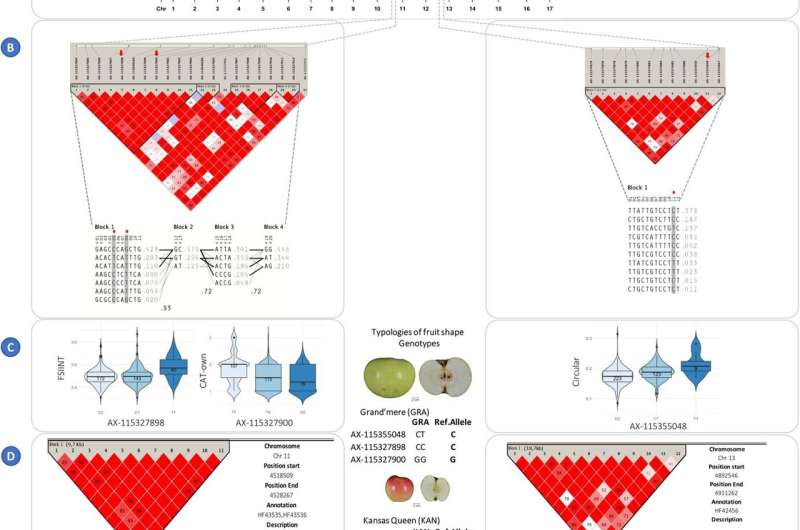This article has been reviewed according to Science X's editorial process and policies. Editors have highlighted the following attributes while ensuring the content's credibility:
fact-checked
peer-reviewed publication
proofread
Unlocking the genetic blueprint of apples: Shape and size traits unveiled

The apple industry faces the challenge of genetic uniformity, with a few dominant cultivars narrowing the genetic base. This reduction in diversity, exacerbated by the unpredictable impacts of climate change on fruit quality and yield, underscores the urgency to broaden the genetic diversity within apple cultivation.
There is a critical need for apple varieties that can withstand environmental stress while remaining commercially viable. Given these challenges, an in-depth exploration of the genetic determinants of pivotal apple traits, specifically fruit size and shape, is essential.
Recent research from the Center for Research in Agricultural Genomics (CRAG) has advanced their understanding of apple genetics. Their study, published on December 19, 2023, in Horticulture Research, applied a robust genomic analysis to pinpoint genes linked to the size and shape of apple fruits.
This study delves into the genomic underpinnings of apple fruit size and shape, utilizing an extensive dataset encompassing 355 apple genotypes from the REFPOP (a European collection of 534 genotypes (accessions and progenies) that represent the current European breeding germplasm.
Through genome-wide association (GWAS), the research team identified 59 single-nucleotide polymorphisms (SNPs) tied to these traits, revealing 71 quantitative trait nucleotides (QTNs) spread across the chromosomes, excluding chromosomes 10 and 15. The discovery of 34 QTNs influencing size and 37 affecting shape has shed new light on the genetic intricacies governing these traits.
The study particularly spotlighted genes such as MdOFP17 and MdOFP4, which show varied expression levels in cultivars with different fruit shapes, indicating their crucial role in fruit development. The RNA-seq data analysis further supports these genes' role in shape regulation, providing a genetic lens through which to view the phenotypic diversity among apple cultivars.
The study's thorough examination of the genetic framework of apple fruit characteristics has not only enriched scientific comprehension but also presented tangible genetic markers that could refine and expedite the apple breeding process.
Dr. Maria José Aranzana, the corresponding author of the study, emphasizes, "Our findings have paved the way for a more targeted approach to apple breeding, focusing not only on enhancing yield and disease resistance but also on meeting consumer preferences for specific fruit attributes such as size and shape."
The identification of these genetic markers could revolutionize apple breeding, enabling the development of new varieties that combine visual appeal with the ability to adapt to diverse climates and resist diseases. This genetic insight has the potential to steer apple production towards greater sustainability and could significantly alter the landscape of the apple industry.
More information: Christian Dujak et al, Genomic analysis of fruit size and shape traits in apple: unveiling candidate genes through GWAS analysis, Horticulture Research (2023). DOI: 10.1093/hr/uhad270
Journal information: Horticulture Research
Provided by TranSpread





















